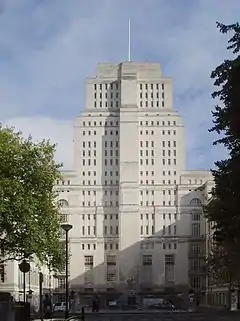UCL School of Slavonic and East European Studies
The UCL School of Slavonic and East European Studies (SSEES /ˈsiːs/) is a school of University College London (UCL) specializing in Central, Eastern and South-Eastern Europe, Russia and Eurasia.
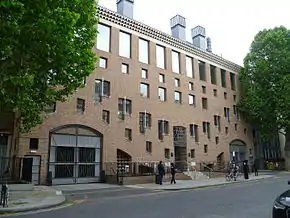 | |
| Established | 1915 |
|---|---|
| Founder | R.W. Seton-Watson |
Parent institution | University College London |
| Director | Professor Diane P. Koenker[1] |
Academic staff | 76[1] |
Administrative staff | 21[1] |
| Students | 900 |
| Undergraduates | 650 |
| Postgraduates | 210 |
| Location | , |
| Campus | Urban |
| Website | www |
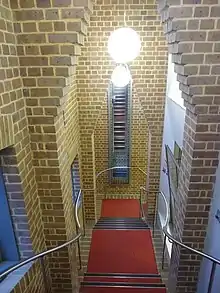
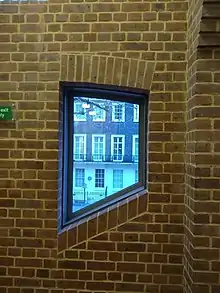
The School teaches a wide range of subjects including the history, politics, literature, sociology, economics and languages of the region and is the largest centre for the study and research of Central, Eastern and South-Eastern Europe, and Russia in the United Kingdom. It has links with universities both across Europe and globally.[2][3]
History
The School was founded by R.W. Seton-Watson in London in 1915, as a department of King's College London, and inaugurated by Tomáš Garrigue Masaryk, who later became President of Czechoslovakia. In 1932 the School became an Institute of the University of London, no longer connected to any college.[4]
In 1999, the School merged with University College London (UCL).
Teaching
More than 60 academic staff work at the School, teaching and conducting research in the history, economics, politics, sociology, anthropology, culture, literature and languages of the countries of Central, Eastern and South-Eastern Europe, and Russia. In 2012/2013 the School had over 200 graduate students studying taught MA degrees or undertaking PhD research. In addition, the School has over 600 undergraduate students.
Research
Along with its undergraduate and graduate teaching, the School hosts a number of interdisciplinary research centres, groups and funded projects which aim to help us expand research and understanding of their specialist regions.[5]
It is a major international centre for training the next generation of regional specialists, through a combination of academic rigour and the skills and knowledge required by employers. It also specializes in analyzing and disseminating information about changes in the region, publishing periodicals, papers and books, holding conferences, public lectures, seminars and briefings, and providing experts who can act as advisers to government, the media, and public and private institutions.
Library
Comprising around 357,000 volumes of books, pamphlets and periodicals, the School's library is unique in the UK for the quantity of research material on open access and for the extensive collection of newspapers from the region. Its collections of books, periodicals and archives are consulted by scholars from all over the world, and it has recently developed an important role in the provision of electronic and audio-visual material relating to its area of study. Central to the School since its founding, the Library moved from Senate House to the new building on Taviton Street in 2005.
The library is one of the leading research collections in Britain for the study of Central and Eastern Europe and the former Soviet Union. The main fields of interest are the languages, literature, history, politics, economics, geography and bibliography of Russia and the western Republics of the former USSR, Poland, the Czech Lands, Slovakia, former Yugoslavia, Hungary, Romania, Bulgaria, Greece, Austria, Germany and Italy. Subsidiary fields of interest are the arts in general, demography, ethnography and religion. Material is also collected on the former German Democratic Republic (history, political and economic life), the history of Germany and Austria, the Lusatian Sorbs, and Slavonic and Ugro-Finnic studies in general.[6]
The Library also houses the Bain Graffy Film Collection of films from and about Russia and Central and Eastern Europe.[7]
Building
In May 2004 the foundation stone of the School's new building on Taviton Street in Bloomsbury was unveiled by the President of Poland, Aleksander Kwaśniewski, in the presence of The Princess Royal, Chancellor of the University of London. The school moved to the building in the summer of 2005 after nearly 90 years at Senate House. Václav Klaus, President of the Czech Republic, delivered the keynote address of his visit to the UK at a ceremony to open the building in October 2005. Following Klaus's address, the Princess Royal unveiled the stone to mark the formal opening of the building, on the occasion of the School's 90th anniversary.
The building was designed by award-winning architects Short and Associates. The design of the building aims to be 'environmentally-friendly' not simply through the addition of elements such as solar panels, but by facilitating the passage of cool air around the building and so avoiding the need for air conditioning or other expensive, energy-using solutions – a first for the 'central London heat island'.[8][9]
Notable alumni and staff
- Acija Alfirević, academic and writer
- Anthony Bailey (BA Eastern and Central European Studies, 1991), interfaith campaigner
- Robin Baker (BA), former Vice-Chancellor of Canterbury Christ Church University
- George Bolsover (Director of SSEES, 1947–76)
- Michael Branch (BA; PhD, 1967; Director of SSEES, 1980–2001)
- Jamie Bulloch (MA, Central and East European History, 1993; PhD, 2002), literary translator
- Sir Roger Carrick (Bulgarian, 1962), diplomat and former UK High Commissioner to Australia
- Robert Conquest (Bulgarian, 1943), historian and poet
- Norman Davies (lecturer then Professor of History, 1971–96)
- Peter J. S. Duncan (senior lecturer of Russian Politics)
- Robert I. Frost (PhD History), historian
- Julian Graffy (Emeritus Professor of Russian Literature and Cinema, and founder of SSEES's Bain-Graffy Film Collection)
- Titus Hjelm (lecturer in Finnish Studies), member of the power metal band Thunderstone
- Sir Robert Hodgson (Chair of SSEES Council, 1943–45), diplomat
- Clare Hollingworth (Croatian), journalist
- Geoffrey Hosking (Chair and Leverhulme Research Professor of Russian History, 1984–2007), academic and co-founder of Nightline
- Lindsey Hughes (Reader then Professor of Russian History, 1987–2007)
- Andres Kasekamp (PhD History, 1996), Director of the Estonian Foreign Policy Institute and Professor of Baltic Politics at the University of Tartu
- David Kirby (former Professor of Modern European History), historian of the Baltic states
- Ivo Lapenna (Reader in Soviet Law, 1964?–unknown), former President of the World Esperanto Association and academic lawyer
- Alena Ledeneva (current Professor of Politics and Society)
- Stephen Lovell (MA, PhD), academic
- Clarence Manning (staff), academic and Slavicist
- Tomáš Garrigue Masaryk (Inaugurated SSEES, Professor of Slavic Research), first President of Czechoslovakia
- Margaret Stevenson Miller (PhD), academic and women's rights campaigner
- Roger Moorhouse (MA History and Politics, 1994), author and historian
- Atukwei Okai (MPhil, 1971), Ghanaian poet, cultural activist and academic
- Sir Bernard Pares (first Director of SSEES, Professor of Russian Language, Literature and History, 1919-1939)
- László Péter (lecturer then Chair of Hungarian history, 1963–94)
- Martyn Rady (current Masaryk Professor of Central European History)
- Sir John Randall (BA Serbo-Croatian language and literature, 1979), former Deputy Chief Whip of the House of Commons
- Anna Reid (History), historian, journalist and author
- Jacek Rostowski (BSc, MA, 1973, then lecturer, 1988–95) former Minister of Finance and Deputy Prime Minister of Poland
- Jonathan Ross (Modern European History), British TV presenter
- Andrew Rothstein (lecturer in Russian and Soviet History, 1946–50), journalist and founding member of the Communist Party of Great Britain
- Mike Sarne (BA), actor, film director and singer of the 1962 UK number one song, "Come Outside"
- Edward Schofield, curator at the British Museum and British Library
- György Schöpflin (former Jean Monnet Professor of Politics), Hungarian Member of the European Parliament
- Robert Service (former lecturer in Russian History), historian and author
- Hugh Seton-Watson (Chair of Russian History, 1951–83)
- R. W. Seton-Watson (founder of SSEES, Masaryk Professor of Central European History, 1922–45), political activist and historian
- Robin Shepherd, political commentator
- Nick Taussig (Master's in Russian Literature), author and film producer
- Trevor Thomas (former lecturer in Czech and Slovak History)
- Mihai Răzvan Ungureanu (former teaching fellow), former Prime Minister of Romania
References
- "People". UCL School of Slavonic and East European Studies (SEES). University College London. Retrieved 1 January 2018.
- "SOLIDARITY/Solidarities PROJECT PARTNERS". European Commission. Retrieved 8 October 2010.
- http://www.ssees.ucl.ac.uk/
- I. W. Roberts, History of the School of Slavonic and East European Studies 1915-1990 (London: School of Slavonic and East European Studies, University of London, 1991).
- UCL (2017-07-24). "Research". UCL School of Slavonic and East European Studies (SSEES). Retrieved 2019-01-03.
- "SSEES Library Guide to Resources".
- "The Bain Graffy Film Collection".
- Contractors page for the project.
- For an account of the design see: Short, C.A., Whittle, G., Owarish, M., (2006) "Fire & Smoke Control in Naturally Ventilated Buildings", Building Research & Information, 34 (1), pp. 21–54 and Short, C.A., Lomas K.J., Woods, A., (2004) "Design Strategy for Low Energy Ventilation and Cooling Within an Urban Heat Island", Building Research and Information, 32 (3), May – June, pp. 187–206.
External links
| Wikimedia Commons has media related to School of Slavonic & East European Studies. |

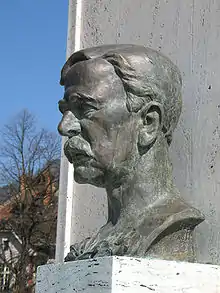

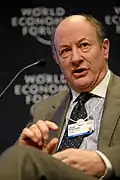
.jpg.webp)
